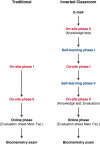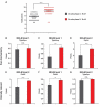Concept and benefits of the Inverted Classroom method for a competency-based biochemistry course in the pre-clinical stage of a human medicine course of studies
- PMID: 28890922
- PMCID: PMC5569983
- DOI: 10.3205/zma001108
Concept and benefits of the Inverted Classroom method for a competency-based biochemistry course in the pre-clinical stage of a human medicine course of studies
Abstract
Background: Medical students often have a problem recognising the relevance of basic science subjects for their later professional work in the pre-clinical stage of their studies. This can lead to a lower motivation to learn biochemical content and dissatisfaction in the courses amongst the students. Alternative teaching methods such as the Inverted Classroom (IC) method can address this deficiency. The goal of this study was: to analyse the motivation and satisfaction of the students in a biochemistry seminar through the use of the e-learning-based IC method, to investigate the acceptance against the IC teaching method in biochemistry, and to compare the learning success achieved using the IC approach with that of a traditional course. We also investigated how a biochemistry course in the pre-clinical stage of a human medicine course of studies can be successfully organised according to the IC method. Furthermore, we examined the benefits of the IC method over conventional teaching formats. Method: The IC method was implemented in accordance with the guidelines of the GMA committee "New Media" [30] in a biochemistry seminar for two student IC intervention groups with 42 students. A part of the factual knowledge from the on-site phase in the form of teaching videos together with self-learning control tasks were provided online before the seminar for both IC intervention groups. Exporting content to the self-learning phase creates new free time in the on-site phase, during which the content can be critically considered and processed and additional competency-based learning objectives can be taught. Identical biochemistry teaching content was taught in parallel control groups (14 student groups with n=299 students), but no material was handed out beforehand for a self-learning phase. These students only received the materials after the on-site phase. Motivation and satisfaction as well as the acceptance for the teaching methods were recorded by questionnaires, the acquisition of knowledge by MC exams. Results: On a Likert scale from 1 (strongly disagree) to 6 (strongly agree), the students in the IC intervention groups could be seen to be much more motivated (5.53) than students in the control group (4.01). Students in the IC intervention groups also recognised the relevance of the learning content much more clearly (5.44) than students in the control group (4.01). Furthermore, the IC group also observed that additional competencies were trained in addition to the biochemistry content. In addition, the IC intervention group award the event a school grade of 1.53, the traditional control group a grade of 2.96. The teaching videos were rated very positively by both groups with an average school grade of 1.3 in each case. A qualitative analysis showed that the motivation and a positive attitude of the lecturers played a decisive role in the successful implementation of the IC method. Discussion and conclusion: Pre-clinical students display a high acceptance of the e-learning-based IC method. Teaching communication competencies in a biochemistry seminar was also rated very positively by the students. The quality of the teaching video and the motivation of the lecturers were shown to be a critical parameter for the successful performance of the IC method. What's more, the IC method can contribute to implementing a competence orientation in medical studies.
Hintergrund: Häufig haben Medizinstudierende Probleme, die Relevanz grundlagenwissenschaftlicher Fächer für die spätere berufliche Tätigkeit bereits im vorklinischen Studienabschnitt zu erkennen. Dies kann bei den Studierenden zu einer geringen Motivation für das Erlernen biochemischer Inhalte sowie zur Unzufriedenheit in Lehrveranstaltungen führen. Alternative Lehrmethoden wie die Inverted Classroom (IC)-Methode könnten diesem Mangel begegnen. Ziel dieser Studie war es, die Motivation und Zufriedenheit der Studierenden in einem Biochemie-Seminar durch den Einsatz der E-Learning unterstützten IC-Methode zu analysieren, die Akzeptanz gegenüber der IC-Lehrmethode im Fach Biochemie zu untersuchen und den durch den IC-Ansatz erzielten Lernerfolg mit dem einer traditionellen Lehrveranstaltung zu vergleichen. Zusätzlich wurde untersucht, wie sich eine Biochemie Lehrveranstaltung im vorklinischen Studienabschnitt der Humanmedizin erfolgreich nach der IC-Methode durchführen lässt und welchen Nutzen die IC-Methode gegenüber herkömmlichen Lehrformaten hat. Methode: Die IC-Methode wurde entsprechend der Leitlinien des GMA-Ausschusses „Neue Medien“ [30] in einem Biochemie-Seminar für zwei studentische IC-Interventionsgruppen mit 42 Studierenden implementiert. Für die beiden IC-Interventionsgruppen wurde ein Teil des Faktenwissens aus der Präsenzphase in Form von Lehrvideos zusammen mit Selbstlernkontrollaufgaben vor dem Seminar online zur Verfügung gestellt. Durch das Auslagern von Inhalten in die Selbstlernphase ergaben sich neue zeitliche Freiräume in der Präsenzphase, in denen die Inhalte kritisch reflektiert und verarbeitet und zusätzliche kompetenzorientierte Lernziele vermittelt wurden. In parallelen Kontrollgruppen (14 studentische Gruppen mit n=299 Studierenden) wurden identische biochemische Lehrinhalte vermittelt, jedoch vorab keine Materialien für eine Selbstlernphase ausgehändigt. Diese Studierenden erhielten die Materialien erst nach der Präsenzphase. Motivation und Zufriedenheit sowie die Akzeptanz für die Lehrmethoden wurde durch Fragebögen, der Wissenserwerb durch MC-Klausuren erhoben.Ergebnisse: Auf einer Likert-Skala von 1 (trifft gar nicht zu) bis 6 (trifft vollkommen zu) zeigten sich Studierende der IC-Interventionsgruppen mit 5,53 signifikant motivierter im Vergleich zu Studierenden der Kontrollgruppe mit 4,01. Auch erkannten Studierende der IC-Interventionsgruppen mit 5,44 die Relevanz der Lerninhalte signifikant deutlicher als Studierende der Kontrollgruppe mit 4,01. Weiterhin nahmen die IC-Gruppen wahr, dass neben den biochemischen Inhalten zusätzliche Kompetenzen trainiert wurden. Darüber hinaus vergab die IC-Interventionsgruppe der Veranstaltung eine Schulnote von 1,53, die traditionelle Kontrollgruppe eine Note von 2,96. Die Lehrvideos wurden von beiden Gruppen mit einer Durchschnittsschulnote von je 1,3 sehr positiv bewertet. Eine qualitative Auswertung ergab, dass Motivation und positive Einstellung der Dozierenden eine entscheidende Rolle für die erfolgreiche Umsetzung der IC-Methode spielte.Diskussion und Schlussfolgerung: Studierende der Vorklinik zeigen eine hohe Akzeptanz gegenüber der E-Learning unterstützten IC-Methode. Weiterhin wurde die Vermittlung von Kommunikationskompetenzen im Biochemie-Seminar von den Studierenden sehr positiv bewertet. Als kritische Parameter für die erfolgreiche Durchführung der IC-Methode zeigten sich die Qualität der Lernvideos und die Motivation der Lehrenden. Darüber hinaus kann die IC-Methode dazu beitragen, eine Kompetenzorientierung im Medizinstudium zu implementieren.
Keywords: Biochemistry; E-Learning; Inverted Classroom; Masterplan Medizin 2020; NKLM; competency-based training; human medicine.
Figures





Similar articles
-
Investigating the self-study phase of an inverted biochemistry classroom - collaborative dyadic learning makes the difference.BMC Med Educ. 2019 Feb 28;19(1):64. doi: 10.1186/s12909-019-1497-y. BMC Med Educ. 2019. PMID: 30819178 Free PMC article.
-
Competency-Based Teaching in Radiology - Implementation and Evaluation of Interactive Workstation-Based Learning to Apply NKLM-Based Content.Rofo. 2017 Nov;189(11):1076-1085. doi: 10.1055/s-0043-117888. Epub 2017 Sep 21. Rofo. 2017. PMID: 28934808 English.
-
Vaccination: Developing and implementing a competency-based-curriculum at the Medical Faculty of LMU Munich.GMS J Med Educ. 2016 Feb 15;33(1):Doc5. doi: 10.3205/zma001004. eCollection 2016. GMS J Med Educ. 2016. PMID: 26958653 Free PMC article.
-
Implementing goals for non-cognitive outcomes within a basic science course.Acad Med. 2002 Sep;77(9):931-2. doi: 10.1097/00001888-200209000-00035. Acad Med. 2002. PMID: 12228102 Review.
-
The use of Facebook in medical education--a literature review.GMS Z Med Ausbild. 2014 Aug 15;31(3):Doc33. doi: 10.3205/zma000925. eCollection 2014. GMS Z Med Ausbild. 2014. PMID: 25228935 Free PMC article. Review.
Cited by
-
Rapid development of a digital module during the Covid 19 pandemic in undergraduate medical education of pediatrics by teachers and students.GMS J Med Educ. 2020 Dec 3;37(7):Doc66. doi: 10.3205/zma001359. eCollection 2020. GMS J Med Educ. 2020. PMID: 33364345 Free PMC article.
-
Flipped classroom as an effective educational tool in teaching physiology for first-year undergraduate medical students.J Educ Health Promot. 2024 Jul 29;13:283. doi: 10.4103/jehp.jehp_1854_23. eCollection 2024. J Educ Health Promot. 2024. PMID: 39310021 Free PMC article.
-
Enhancing the effectiveness of flipped classroom in health science education: a state-of-the-art review.BMC Med Educ. 2022 Jan 12;22(1):34. doi: 10.1186/s12909-021-03052-5. BMC Med Educ. 2022. PMID: 35022002 Free PMC article. Review.
-
Development of an interactive e-learning software "Histologie für Mediziner" for medical histology courses and its overall impact on learning outcomes and motivation.GMS J Med Educ. 2020 Apr 15;37(3):Doc35. doi: 10.3205/zma001328. eCollection 2020. GMS J Med Educ. 2020. PMID: 32566737 Free PMC article.
-
Medical students in their first consultation: A comparison between a simulated face-to-face and telehealth consultation to train medical consultation skills.GMS J Med Educ. 2023 Sep 15;40(5):Doc63. doi: 10.3205/zma001645. eCollection 2023. GMS J Med Educ. 2023. PMID: 37881523 Free PMC article.
References
-
- Bishop JL, Verleger MA. The flipped classroom: A survey of the research. 120th ASEE Annual Conference Exposition; June 23-26, 2013; Atlanta.
-
- Bohaty BS, Redford GJ, Gadbury-Amyot CC. Flipping the classroom: assessment of strategies to promote student-centered, self-directed learning in a dental school course in pediatric dentistry. J Dent Educ. 2016;80(11):1319–1327. - PubMed
-
- Bösner S, Pickert J, Stibane T. Teaching differential diagnosis in primary care using an inverted classroom approach: student satisfaction and gain in skills and knowledge. BMC Med Educ. 2015;15:63. doi: 10.1186/s12909-015-0346-x. Available from: http://dx.doi.org/10.1186/s12909-015-0346-x. - DOI - DOI - PMC - PubMed
-
- Comert M, Zill JM, Christalle E, Dirmaier J, Harter M, Scholl I. Assessing Communication Skills of Medical Students in Objective Structured Clinical Examinations (OSCE)-A Systematic Review of Rating Scales. PloS one. 2016;11:e0152717. doi: 10.1371/journal.pone.0152717. Available from: http://dx.doi.org/10.1371/journal.pone.0152717. - DOI - DOI - PMC - PubMed
-
- Critz CM, Knight D. Using the flipped classroom in graduate nursing education. Nurs Educ. 2013;38(5):210–213. doi: 10.1097/NNE.0b013e3182a0e56a. Available from: http://dx.doi.org/10.1097/NNE.0b013e3182a0e56a. - DOI - DOI - PubMed
Publication types
MeSH terms
LinkOut - more resources
Full Text Sources

